Water supply to a country house from a well: specifics of providing private houses with well water
One of the most popular options for organizing water supply in a private home is the use of well water.Compared to a well, the costs of constructing a well look quite moderate. And this anciently known structure is much simpler to operate.
Over time, carrying water into the house in buckets becomes boring, and the idea of establishing a water supply for a country house from a well looks more and more attractive. All that remains is to find out the nuances of this process and begin to implement bold plans. Moreover, some craftsmen managed to dig a deep well almost alone.
We suggest that you familiarize yourself with the rules and features of the design of a water supply system from a well to water collection points in the house. Here you will learn how and according to what schemes the assembly of water supply circuits is carried out. For visual understanding, we have attached photos, diagrams and videos to the text.
The content of the article:
Pros and cons of the “well” option
Before starting such a large-scale project, you should evaluate its pros and cons. In addition to the relatively low construction costs, it is worth noting the ability to use the well even during power outages, simply by collecting water with a bucket. In addition, a well does not require permits; it can simply be dug in a suitable location.
But we should not ignore some of the problems associated with water supply from a well.Water in the upper horizon is rarely of high quality, which will invariably affect the operation of the equipment. For technical needs it is quite acceptable, but for drinking and cooking it is usually not suitable.
To provide your home with clean water, you will have to dig a fairly deep well. Unlike a well, a well needs regular cleaning, which should be done once or twice a year. To improve the quality of your well water, it is recommended to install a reliable filter system.
Contamination from floodwater and sewage is a familiar problem for many well owners. To avoid it, special protective measures will be needed. Another problem is the seasonal change in groundwater levels, which can be very significant.
Sometimes the appearance of a well on a site changes the nature of the groundwater beneath the surface of the site in such a way that a threat to the integrity of the foundation may appear. To prevent such a problem, you should consult with a specialist or discuss the situation with neighbors who already have a well.
What should a good well look like?
First, choose a location for the well. It must meet several requirements:
- be located in a place where the aquifer is as close to the surface as possible;
- be located as close to home as possible;
- be located at a considerable distance from possible sources of pollution: cesspools, places where pets are kept, etc.
If such a place is chosen, work can begin. The process will remove significant volumes of soil. In order not to contaminate the site, you should take care in advance of a suitable place for the excavated soil. For example, it can be used to improve the terrain of a home garden.
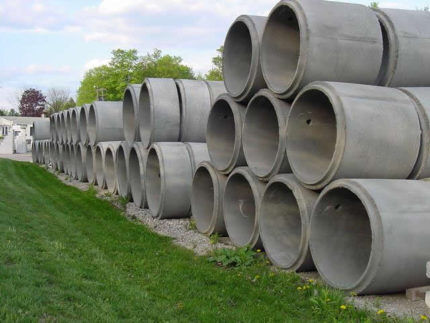
Various materials are used to form the walls of the well: brick, stone, logs, etc.But the vast majority of modern wells are made from concrete rings.
This is an accessible and relatively inexpensive material, reliable in operation and easy to install. Of course, the gaps between the rings are carefully sealed and covered with waterproofing materials.
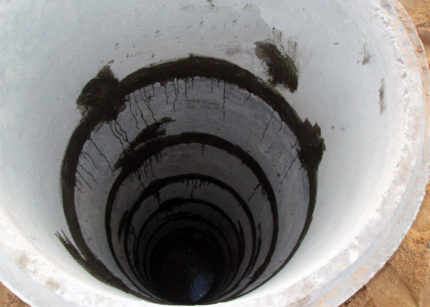
When choosing rings for a well, there are several important points to consider:
- use special concrete rings for wells that have not been used;
- remember that cheap rings, especially used ones, have a reduced durability and may have contaminants that will affect the quality of well water;
- It is unacceptable to use rings with cracks or other technical defects;
- When receiving the rings delivered to the site, measure their height and other parameters with your own tape measure, especially if the construction of the well is entrusted to a team that receives payment depending on the number of rings.
Another important point is the debit of the well, i.e. the amount of water that can be obtained in a short period of time. To determine this indicator, water is pumped out and then its volume is measured.
To make a well from concrete rings, they dig a shaft into which the rings are gradually lowered, placing them one on top of the other. The correct installation is checked with a plumb line. It is also necessary to ensure that the shaft is sufficiently spacious and level.
Is there already a well on the property? This does not mean that you can immediately purchase pumping equipment. First, you should check whether the design meets the requirements for water supply to a private house from a well: its depth, debit, etc.
In any case, cleaning must be carried out before installing the system. If it is necessary to deepen an existing well, the water is pumped out, the shaft is deepened and its walls are reinforced with concrete rings of smaller diameter.
Options for organizing well water supply
There are two common home water supply schemes from a well: using a storage tank or pumping station. In the first case, a special container is used, into which water is supplied using a suitable pump.
From the storage tank, water flows into the house's plumbing system. In the second case, a pumping station with a hydraulic accumulator tank and an automatic control system is used. Both methods have their advantages and disadvantages, the choice should be made depending on the situation.
Option #1 - systems with a storage tank
The storage tank should be installed as high as possible. Usually they choose a suitable location on the top floor or install it in the attic. If the attic is not heated, it is necessary to insulate the storage tank, otherwise in winter the water in it may simply freeze.
The higher the tank is located, the greater the pressure in the water supply network of the house. In addition to the tank you will need pump - submersible or surface.
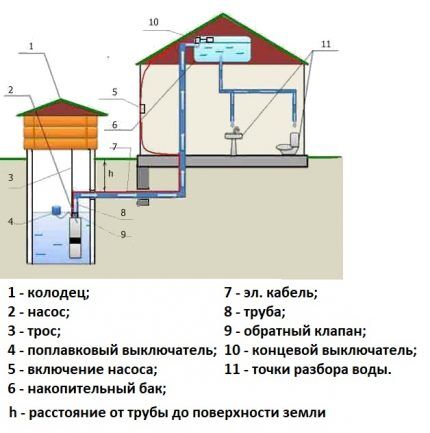
However, it should be remembered that such a system usually provides the minimum permissible pressure levels. Each meter of height of the water column will give approximately 0.1 atm. pressure in the system.
The pump with which the tank is filled with water can be turned on manually or its operation can be automated. In any case, it is necessary to provide for the installation of a special tube that will protect the tank from overfilling.

A system with a storage tank is good because it creates a significant supply of water in the house, which can be used as usual, even if the power supply to the pump is cut off for some reason.
In addition, the costs of creating such a water supply system are not so small. The main disadvantage of such a system is the relatively low pressure in the water supply. And home owners do not have the opportunity to arbitrarily change this indicator.
Option #2 - water supply with a pumping station
A pumping station is a device that combines a pump, a hydraulic accumulator and automatic relay, which controls the operation of this pump.
If you supply water to the water supply directly after it is drawn by the pump, the equipment will turn on every time someone uses water in the house. Of course, in such conditions, any pumping equipment soon fails.
When using a pumping station, the device turns on only to fill the accumulator tank when the amount of water in it reaches a minimum level. As soon as the tank is full, the relay automatically turns off the pump. It will turn on again only after the tank is empty, etc.
You can assemble a pumping station yourself, but ready-made units with various characteristics and at quite affordable prices are available for sale. They are equipped with both submersible and surface pumps of different capacities.
It should be remembered that if the submersible pump breaks down, it will first have to be removed from a fairly significant depth. But with surface models another problem arises - they make a lot of noise.
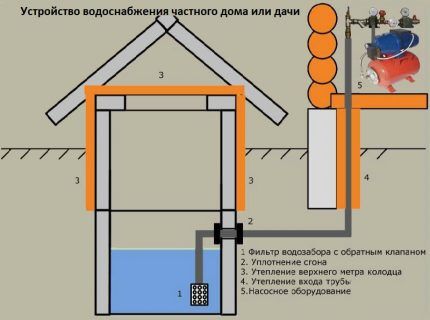
like this pumping station It is best to place it as far from the house as possible. Or it is worth taking care of additional noise insulation of the room if the equipment is installed in the house.
The pumping station is not a very large device; such a unit will not take up much space. But the capacity of the hydraulic accumulator is also small, so if the power goes out, water will almost immediately stop flowing into the system; you will have to use a bucket on a rope.
When choosing a suitable pumping station, you should pay attention to the power of the equipment, the height of the water supply, the performance of the unit, as well as the volume of the membrane tank - hydraulic accumulator. Additionally, you should make sure that the unit is equipped with overheating and dry-running protection systems.
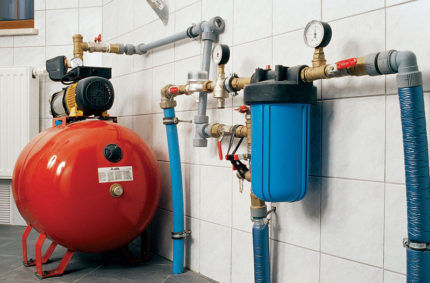
There are devices on sale with manual, automatic and even remote control; you need to decide in advance about your own wishes in this regard.
For permanent use, fully automated systems are usually chosen, but for a summer house, which is used only in the summer, inexpensive manually controlled equipment is quite suitable.
The power and productivity of the pumping station are determined by the need for water.So, for a small dacha, a device with a capacity of 600-1000 l/h is quite enough, but for a private house in which a family of four permanently lives, it makes sense to choose a more powerful device - 3000-6000 l/h.
The larger the volume of the accumulator, the less discomfort a power outage will cause, since more water will remain in the system. But such a station will cost more and will be a little more difficult to install.
The price is also affected by the material from which the tank is made. Plastic is cheaper, and cast iron, which has a longer service life, is more expensive. The presence of protective systems also significantly affects the price, but it is unwise to refuse them and risk expensive equipment.
You will find valuable recommendations on choosing a pumping station for arranging a suburban area in another popular article our site.
External and internal water supply
If the choice between a storage tank and a pumping station has been made, it’s time to begin performing the necessary set of works. Regardless of the chosen system, it is necessary to install the plumbing system, namely its external and internal parts.
A trench should be dug outside so that the pipe runs below the freezing level of the soil in that particular area. In this case, a slope of 3 cm is maintained for each meter of the highway.

The pipe in the area above the freezing horizon before entering the house must be insulated.In cases where the pipeline is laid above the seasonal freezing horizon, the problem is solved with the help of a heating cable. It is convenient to place the pump's electrical cable in the trench under the pipeline. If its length is not enough, the cable can be “extended”.
But it is best to entrust this operation to an experienced electrician, since in the event of a breakdown you will have to carry out large-scale excavation work or even completely replace part of the damaged equipment.
Suitable for outdoor water supply plastic pipes. A trench is brought to the well, a hole is made in its wall through which a pipe is inserted. The pipeline branch inside the well is expanded using fittings, which will also provide the cross-section necessary for a stable flow of water.
If the water supply diagram includes submersible pump, it is attached to the edge of the pipe and lowered into the well. If a pumping station will pump water, the edge of the pipe is equipped with a filter and a check valve.
The distance between the bottom of the well and the lowest point of the pumping system must be at least a meter so that grains of sand disturbed by the operation of the machine do not fall into it.
The hole around the pipe entrance is carefully sealed with cement mortar. To prevent sand and dirt from entering the system, a regular mesh filter is placed at the lower end of the pipe.
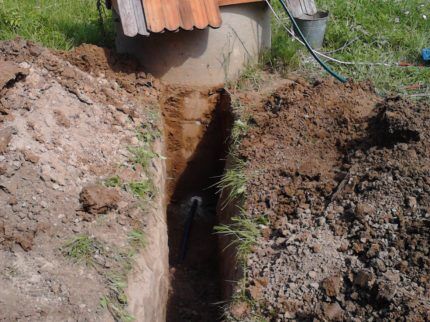
A long pin is driven into the bottom of the well. A pipe is attached to it to securely fix its position. The other end of the pipe is connected to a hydraulic accumulator or storage tank, depending on the type of system chosen.
After the trench is buried, a clay castle should be installed around the well with the following parameters: depth - 40-50 cm, radius - about 150 cm. The castle will protect the well from the penetration of melt and groundwater.
To the house water supply is introduced so that this place is hidden under the floor. To do this, you need to partially excavate the foundation to make a hole in it.
Installation of internal water supply can be done from metal pipes, but owners of country houses almost always choose modern plastic structures. They weigh lighter and are easier to install.
You need a soldering iron for PVC pipes, with which the ends of the pipes are heated and reliably connected.Even a novice craftsman can do this kind of soldering on his own, but you should become familiar with common mistakes when soldering PVC pipes in order to ensure a truly reliable connection.
Here are some useful rules:
- soldering work should be performed in a clean room;
- the joints, as well as the pipes as a whole, should be thoroughly cleaned of any contamination;
- any moisture from the outside and inside of the pipes must be carefully removed;
- You should not keep the pipes on the soldering iron for a long time to avoid overheating;
- heated pipes should be connected immediately and held in the correct position for several seconds to prevent deformation at the connection point;
- It is better to remove possible melts and excess material after the pipes have cooled.
If these rules are followed, a truly reliable and durable connection is obtained. If the soldering is done poorly, the connection may soon leak, which will lead to the need for large-scale repair work.
Installation of a water supply system
A few useful general rules will help you properly arrange water supply for the dacha or a cottage from a well:
- it is necessary to correlate the performance of the pump and the hydraulic exchange rate of the well so that the pumping equipment does not run idle if the water in the well does not have time to accumulate;
- as a protective measure, the pump should be equipped with an automatic unit that will shut down the equipment if water stops flowing into the system;
- when sealing the entrance of a water pipe into the wall of a well, it is recommended to pay special attention to the reliability of the seal, using multi-layer insulation, which includes not only cement mortar, but also a layer of silicone and liquid glass;
- so that in the event of equipment failure, water does not flow out of the system back into the well, a special check valve should be installed;
- in addition to the mesh filter at the end of the water pipe lowered into the well, it is recommended to use an additional mechanical cleaning filter, which is installed after the pump;
- filters should be selected and placed in such a way that it is easy to maintain them, in particular, replace cartridges;
- In case of an accident, it is imperative to install a drain valve, which will completely remove water from the system if the equipment suddenly breaks down.
The easiest way to install a system is with a storage tank and a manually controlled pump. When installing and connecting the pumping station, you should carefully study the manufacturer’s recommendations and follow them exactly.
Stage #1 - install the pump and storage tank
The process of installing a system with a storage tank is relatively simple. It is necessary to install a tank; for this, a container made of stainless steel or plastic is usually used. The more water it holds, the better, but remember that this creates additional load on the floors and foundation.
To correlate the load-bearing capacity of building structures with the increased load, engineering calculations may be necessary. As mentioned earlier, it is recommended to insulate the tank.
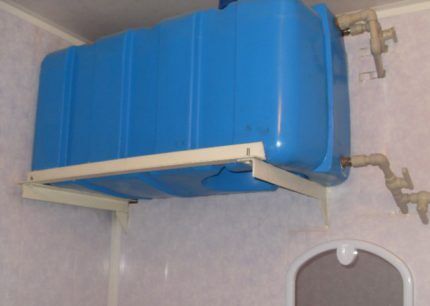
The second important element of this system is the pump. If water is drawn from a depth of less than 9 meters, a surface self-priming pump can be used.Such models are cheaper and easier to operate, but for them to work correctly you will need an insulated room: basement, utility room, etc.
Sometimes an auxiliary building is placed next to the well. If the depth of water intake exceeds 9 meters, you will need a special deep pump. Both vibration and centrifugal models can be used in wells.
Stage #2 - connect the pumping station
For the pumping station, you can also arrange a utility room near the well or place it directly in the house. If you decide to install it below ground level, you should dig a recess so that all equipment is located below the freezing point of the soil. The chamber for pumping equipment is carefully insulated.
First install membrane hydraulic tank and a pump, then a monitoring relay is connected to the system. It is connected to the water supply system using a special adapter tap.
The connection procedure is usually indicated on the cover of the device or in its instructions. The already installed factory settings are not always suitable for a particular situation, so the relay will almost certainly have to be configured in a new way.
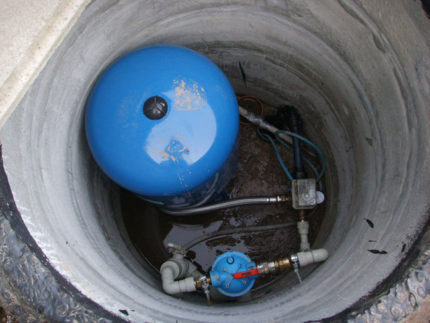
For the pumping station, a separate power supply line with an automatic switch for emergency shutdown should be provided. After this, the system is turned on and its operation is checked.
Particular attention should be paid to the junctions of system elements with water pipes in order to immediately eliminate possible leaks.
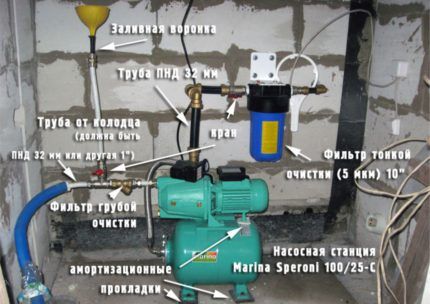
If the installation of an autonomous water supply from your own well is done correctly, it will function successfully for many years. It is only necessary to regularly carry out the necessary maintenance: cleaning the well, replacing filters, checking the settings of the automatic control system, etc.
A skilled craftsman can perform a significant part of all the work on his own, but for complex operations, for example, soldering PVC pipes or connecting electrical systems, it makes sense to invite a specialist.
Conclusions and useful video on the topic
The following video provides detailed tips on how to independently assemble and install a pumping station:
For comfortable and stable autonomous water supply, pumping stations are most often used. They are reliable and easy to maintain.
A storage tank system is a low-cost water supply option and is more suitable for temporary rather than permanent use.
Would you like to share your personal experience in installing water supply in a suburban area? Do you have any questions while reading the information we provide? Please leave comments.




Oh, with these wells, I’ve already suffered so much. Our house is located on a hill, and we were digging a well with 16 rings. Our neighbors, who are lower in level than us, have wells of 12-13 rings and have water - everything is fine. But we dug, but only one ring gets enough water.I can’t imagine what to do, either dig further, but much further, or still drill a well. Tell me what to do, I will be very grateful. Thank you in advance.
Your situation is very familiar to me; the problem may be that the sources are contaminated. I would advise you to clean the well, if there is no result, then you can go deeper, because you have water, it just does not have time to be restored. Or they hit a weak source. A well is again a big financial expense, so I wouldn’t rush to do it.
Hello. Unfortunately, without a geo-study of groundwater it is difficult to answer. In addition, it would be advisable to find out what kind of water you have. But in general, it would have been better to carry out control drilling before constructing the source and check how things were going with the water carrier there.
The problem may be seasonal, mechanical (when there is depressurization of the rings and water seeps into the ground), you may have siltation at the bottom or the wrong location for the well has been chosen, construction work is taking place at your neighbors, and so on.
I recommend that you invite a specialist to assess the situation directly on the spot.